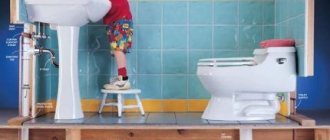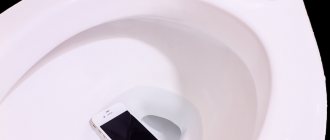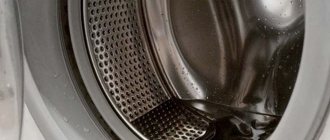Anyone can face the unexpected problem of a stagnant toilet. There is no point in putting off fixing plumbing problems. Let's look at the signs and causes of a clog in the toilet and learn how to remove a clog in the toilet with your own hands.
You can understand that the toilet is faulty by the following signs:
- dirty water does not leave the toilet completely after flushing;
- unpleasant odors appeared in the toilet;
- when flushing, the water fills the toilet bowl approximately halfway;
- The water goes down the drain very slowly.
If at least one of the listed signs is present in your toilet, we can confidently state that it is clogged and the drain needs to be cleaned.
Cleaning a clogged toilet using a plunger
Removing a blockage using a plunger is a mechanical method and is suitable for removing a blockage. If you suspect that a foreign object (child's toy, rag) has gotten into the toilet, it is better to remove it before you start working with the plunger.
You can remove objects by wearing rubber gloves. Otherwise, there is a risk of pushing debris further down the pipe and blocking the sewer system. A plunger is an effective remedy for clogged toilets.
- Before starting work, close all drains (bathtub, sinks).
- Place the plunger into the toilet drain hole. Pour five to six liters of water on top so that the rubber part of the plunger is completely covered.
- Pump the plunger at least ten times up and down. Movements should be sharp, but uniform. If the water goes away, then everything is done correctly.
Preventive measures
To avoid toilet paper clogging your toilet:
- Buy plumbing fixtures from trusted manufacturers who care about their reputation and supply quality products. Check the quality certificate, save receipts so that, if necessary, replace an unusable copy;
- Install the toilet correctly , in accordance with the user manual. If you have even the slightest doubt about your talent as a plumber, it is better to contact specialists;
- Teach all household members, especially children, to use toilet paper sparingly , of course, within the required limits. If that doesn’t work, suggest washing it off in parts. A little more water will be consumed, but the risk of clogging will be minimized.
Any item requires careful handling. Use the toilet correctly, do not throw unnecessary things into it, and it will serve you flawlessly throughout its entire service life.
Subscribe to our Social networks
Clearing a toilet blockage with a plastic bottle
You can quickly get rid of a clog in the toilet using improvised means. For example, using a regular plastic bottle with the bottom cut off and the cap tightly screwed on.
- The device must be carefully and slowly inserted into the drain.
- As soon as you feel the air pushing the bottle back, push it sharply to the very end of the drain hole. After this, remove the bottle from the drain with a sharp movement.
The water will go away and the congestion will be eliminated if the procedure is repeated two or three times.
Locating the traffic jam
Before removing the blockage in the toilet, determine the place where it formed, and for this you will need to inspect the sewer riser in the bathroom and kitchen. It should be remembered that the problem is common if the apartment is located in an apartment building.
In a private household, if you have to remove a clogged toilet yourself, you need to look for the cause outside the building on the street in the place where the pipe is directed into the cesspool, or in the area where the local sewerage system is connected to the citywide system.
The fact that the blockage is common is indicated by liquid that cannot be drained from the bathroom. In a situation where, with the simultaneous use of a drain in the kitchen sink and in the toilet, the liquid flows unhindered, the cause of the problem is located in another place - where there is stagnation.
Clean the toilet with a solution of baking soda and vinegar
Vinegar and baking soda will help break through simple clogs in the toilet. You should not use this cleaning method if the corrugation (connection of the toilet bowl and pipe) is made of plastic. Hot water with baking soda and vinegar can ruin thin plastic.
Using vinegar and soda, you can quickly and effectively clean the toilet from contaminants such as grease plugs and food waste.
- Take half a packet of baking soda and pour it into the drain hole.
- Prepare one glass of vinegar and pour it into the toilet bowl.
- Wait half an hour and pour 3-5 liters of boiling water into the drain.
Toilet clogged with toilet paper or tampon
To avoid having to deal with the problem of how to unclog a toilet at home, you should not put anything into the device other than toilet paper, which has the ability to dissolve in drains. Anything else will certainly clog the sewer pipeline.
It is also prohibited to flush fat formed in frying pans into the toilet. They need to be wiped with a paper towel and then thrown into the trash. You should not put used tea leaves into a plumbing fixture, as it can clog pipes, similar to cement.
The problem of how to break through a blockage in the toilet will certainly appear if the construction waste remaining after the repair is flushed into it. It is unacceptable to throw food residues into the sewer system, as they can cling to irregularities inside the pipes and, over time, make them impassable.
Another reason why the toilet is clogged is diapers, sanitary pads and tights, plastic bags and other hygiene items that fall into the sewer.
How to break through a blockage with a cable
Using a special sewer cable will help you quickly and efficiently get rid of the blockage. It is better to do the work together.
Prepare unnecessary rags, oilcloth, a bucket or basin with water and dishwashing detergent.
- Roll out the oilcloth on the floor and cover the walls.
- Place the end of the cable into the drain hole and slowly move it down using a rotating motion.
- Once the cable has stopped and won’t go any further, move it back and forth.
- Remove the cable by lowering it onto the oilcloth. Clean with a cloth soaked in dishwashing liquid to remove unpleasant odors.
Why does this happen?
There may be several reasons for this. Among them:
- Exceeding the "limit" of paper in the toilet. When there is too much of it, it forms a dense lump that gets stuck at the bottom of the bowl, siphon or drain pipe. The culprits of such incidents are most often children who, fearing to get dirty, tear off long strips from the roll and fold them several times. Repeated repetition of the action leads to the accumulation of meters of cellulose at the bottom of the toilet.
- The presence of a hidden defect in a ceramic product, which manifests itself over time and prevents the correct operation of plumbing fixtures. Unfortunately, not all manufacturers are responsible for the quality of their products, and their victims are mainly buyers who want to save money.
- Incorrect installation, for example, installing a sewer outlet at the wrong angle in combination with insufficient water pressure in a toilet with a circular flush.
- The absence of an air valve on the sewer drain of the upper floor, which maintains stable pressure in the system, preventing the air inside it from becoming rarefied.
Fourth option – mustard and hot water
In this case, powder mustard and hot water are used to clean the toilet (one small spoon of mustard powder is taken for two liters of water), and the composition is prepared as follows:
- 6÷8 liters of water are heated in a metal bucket or pan.
- Then add 3-4 tablespoons of mustard into it and mix.
- The solution is poured into the toilet and left for 15–20 minutes.
- After this, it is necessary to drain the water from the tank or from the filled bucket.
If necessary, the process must be repeated several more times.
Let's sum it up
The most effective way to clear a drain from clay, cat litter, fresh fruit or other solid objects is a cable. The hydraulic method is indispensable for fatty blockages. And household chemicals specialize in eliminating food waste. Most often it is sold in portioned bags containing special granules or powder. Preventative chemicals intended for monthly use are sold in the form of gels and thinner substances.
Video on the topic
Knowing how to unclog a toilet yourself if it’s clogged will not prevent it from becoming clogged. But regular and unconditional compliance with preventive measures and operating rules for plumbing will certainly keep this unpleasant problem away from you. It’s not for nothing that they say: “Forewarned is forearmed.”
When do you need a plumber
In difficult cases, such as all the pipes are clogged, you will not be able to break through the blockage yourself. A sign of a severely clogged toilet is when flushed waste floats up through drains in bathtubs or sinks.
If neighbors also complain about such a problem, then the cause must be looked for in the sewer system outside the apartment. Only a plumber can remove such a blockage.
You will also need the help of a specialist if the listed pipe cleaning methods, including chemical ones, do not work. The plumber will find out the reason for the stagnation of water and break through the mud blockage.
Features of home sewerage
Sewage is an integral part of the drainage and water supply system.
It is designed to remove liquid and solid products of human activity, to purify household water from contaminants and return them for further use or into a reservoir. A sewerage system is necessary for comfortable living in a house or apartment. Residents of apartment buildings are responsible for the condition of sewer pipes in the apartment, and owners of private properties must independently install local treatment facilities, remove sewage, and maintain pipelines and equipment.
In order to avoid unpleasant problems in the future, you should comply with the requirements of SNiP regulations on water drainage and sewerage. Then the system will work normally, without requiring constant monitoring or adjustment.
Having a properly designed and installed sewerage system will make life more comfortable, help maintain environmental balance on the site and extend the life of buildings
The internal sewer networks include:
- plumbing fixtures with water drainage;
- common riser which sewer pipes are connected;
- pipe layout that ensures the process of transporting wastewater from the drain hole to the riser.
Requirements for internal networks are specified in SNiP “Internal sewerage”, in GOST and SNiP “Sewerage”. The systems are installed inside the building and ensure the transportation of all wastewater from the place of its formation to the pipe exiting the building.
Basic requirements for internal networks:
- When installing plumbing fixtures on drains, a water seal is required.
- Cast iron or plastic pipes are used for laying networks.
- The diameter of the sewer system outlet from the house is at least 110 mm.
- When laying pipes, a slope of 2 to 2.5% must be maintained.
The internal networks of the sewer system must be equipped with ventilation. The process of ventilating the networks is carried out through common sewer risers - an exhaust part is installed, leading to the roof.
The main reason for clogged sewer pipes in the bathroom is a significant accumulation of fat and other deposits on the inner surface of the pipe.
Due to the resulting blockages, normal drainage of wastewater becomes impossible, so it is necessary to immediately resume the full functioning of the sewer system. In order to avoid unpleasant consequences due to a blockage in the pipeline, you need to call specialists or clean the sewer yourself.
Who to call if the toilet is clogged?
Of course, it makes no difference to the emergency service - private or public. After all, in this case, speed is important, not departmental affiliation. Therefore, dial any phone number that catches your eye on the Internet or in a directory.
Just don’t forget to check the cost of the emergency crew. The average price per visit is 4000-5000 rubles. At the same time, mechanical cleaning (with a cable) costs from 2000 rubles. And flushing the system using a hydrodynamic nozzle (a jet of water under enormous pressure) costs from 8,000 rubles.
Where can you find such masters?
The Plumber Service company employs high-class craftsmen. They will determine the exact cause of the clog, develop a plan to clear the clog, and, if necessary, replace the pipes to prevent reoccurrence.
In case the toilet is clogged, it would be ideal to call those who can help and advise. And only after a telephone consultation, call the experts with a cool head. Call our simple number and the issue will be resolved!











